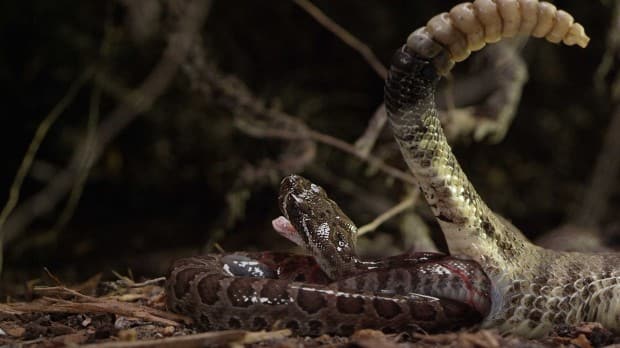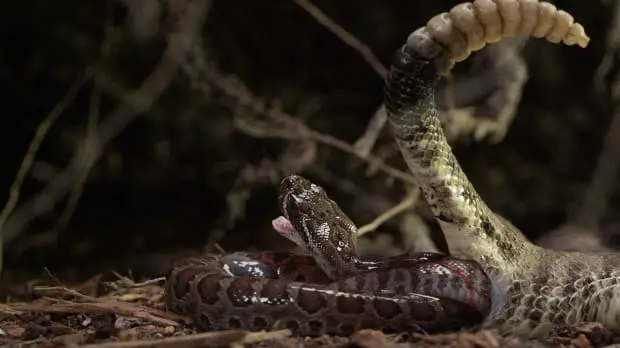Rattlesnakes are fascinating creatures that have captured the curiosity of many people. One of the most common questions about these venomous snakes is when they are born. Understanding the timing of their birth can help us better appreciate and protect these creatures. In this article, we will explore the life cycle of rattlesnakes and answer the question, “When are rattlesnakes born?”
Rattlesnakes are born in late summer or early fall, usually between August and October. The exact timing of their birth varies depending on the species and location. Baby rattlesnakes are born live and are fully venomous from birth. They typically have a rattle that is not yet functional and are left to fend for themselves from the moment they are born.

When Are Rattlesnakes Born?
Rattlesnakes are a fascinating species of snake that are recognized by the distinctive rattle located at the end of their tail. These venomous snakes are found throughout North and South America, and they are considered to be the largest group of venomous snakes in the world. If you are interested in learning about the lifecycle of rattlesnakes, then you might be wondering: when are rattlesnakes born?
Seasonal Timing
Rattlesnakes are generally born in the late summer or early fall, typically between August and October. This timing allows the young snakes to have ample time to grow and mature before the onset of winter. In general, female rattlesnakes will give birth to their offspring in a protected location such as a burrow or crevice in a rock.
Once born, the baby rattlesnakes are completely independent and must immediately begin hunting for their own food. They are born with venom and fangs, and they are capable of delivering a venomous bite from the moment they are born.
Mating and Reproduction
Rattlesnakes mate in the spring, and the gestation period for the females is around four to five months. The female will carry her offspring internally until they are born, and she typically gives birth to anywhere from 2 to 25 young.
Interestingly, rattlesnakes are capable of reproducing asexually, meaning that they are able to produce offspring without the need for a male to fertilize their eggs. This process is known as parthenogenesis, and it occurs very rarely in wild populations of rattlesnakes.
Babies and Survival
The survival rate for baby rattlesnakes is relatively low, as they are vulnerable to predators and have a high risk of starvation. However, those that do survive have a high potential for growth and development, and they can reach maturity within two to four years.
One of the primary benefits of the rattlesnake’s venomous bite is its ability to immobilize prey, making it easier for the snake to capture and consume. This allows the baby rattlesnakes to quickly develop their hunting skills and become proficient predators.
Rattlesnakes vs. Other Snakes
Rattlesnakes are often compared to other species of snakes, particularly those that are also venomous. One of the primary differences between rattlesnakes and other venomous snakes is the presence of the rattle. This unique feature allows the rattlesnake to warn potential predators and humans of their presence, reducing the risk of accidental encounters.
Additionally, rattlesnakes are known for their relatively docile behavior and tendency to avoid confrontation whenever possible. They will typically only deliver a bite if they feel threatened or provoked, and will often give ample warning before doing so.
Conclusion
Rattlesnakes are fascinating creatures that play an important role in their ecosystems. By understanding when rattlesnakes are born and how they develop, we can better appreciate these unique and valuable creatures. Whether you encounter a rattlesnake in the wild or simply appreciate their beauty from afar, it is important to approach them with caution and respect.
Frequently Asked Questions
Here are some common questions about rattlesnakes and their birth cycles.
What time of year do rattlesnakes give birth?
Rattlesnakes typically give birth in the late summer or early fall, between August and October. This is when the young rattlesnakes are most likely to survive, as they have a better chance of finding food and avoiding predators. Female rattlesnakes will often give birth to litters of 6-10 babies, known as neonates.
When the babies are born, they are completely independent and must fend for themselves. They are born with fully functional venom glands and fangs, but their venom is not as potent as that of adult rattlesnakes. It takes several years for a rattlesnake to reach its full size and become sexually mature.
How long is the gestation period for a rattlesnake?
The gestation period for a rattlesnake varies depending on the species, but it is typically around 3-4 months. During this time, the female rattlesnake will carry her babies inside her, nourishing them with yolk sacs until they are ready to be born. Some species of rattlesnakes, such as the Eastern diamondback, have longer gestation periods of up to 6-7 months.
After the babies are born, the female rattlesnake will usually return to her den for the winter. Male rattlesnakes will also hibernate during the winter months, but they do not give birth or care for their young.
Do all rattlesnakes give birth to live young?
No, not all rattlesnakes give birth to live young. Some species, such as the timber rattlesnake and the Eastern diamondback, are viviparous and give birth to live young. Other species, such as the Western diamondback and the prairie rattlesnake, are oviparous and lay eggs.
The eggs of oviparous rattlesnakes are typically laid in the summer and hatch in the fall. The young snakes are then on their own, as the mother does not provide any care or protection for them.
How many babies do rattlesnakes have at once?
Rattlesnakes can have anywhere from 1-25 babies at once, depending on the species. Most species of rattlesnakes have litters of 6-10 babies, but some, such as the Eastern diamondback, can have litters of up to 25 babies.
The size of the litter depends on a number of factors, including the size and age of the mother, the availability of food and water, and the health of the mother. Larger, healthier mothers are more likely to have larger litters than smaller, less healthy mothers.
How long do baby rattlesnakes stay with their mothers?
Baby rattlesnakes are born completely independent and do not stay with their mothers for any length of time. As soon as they are born, they must fend for themselves and find food and shelter on their own.
However, baby rattlesnakes are more vulnerable to predators than adult rattlesnakes, so they will often seek shelter together in underground dens or other protected areas. This can help to increase their chances of survival during their first few months of life.
Unlivable Rattlesnake Gives Birth To Live Young After Carrying Eggs Inside
In conclusion, understanding the timing of rattlesnake births is important for both their survival and our own safety. While the exact timing can vary depending on the species and location, most rattlesnakes give birth in late summer or early fall. It’s important to remember that these snakes are an important part of the ecosystem and play a vital role in controlling rodent populations.
If you’re planning on hiking or spending time in areas where rattlesnakes may be present, it’s important to be aware of their typical habits and behaviors. Keep an eye out for signs of their presence, such as shed skins or rattles, and always give them a wide berth if you do encounter one. With a little knowledge and caution, we can coexist safely with these fascinating creatures.
In the end, it’s amazing to consider the intricacies of the natural world and the many ways in which different species adapt and thrive. By understanding the timing of rattlesnake births, we gain a deeper appreciation for these fascinating creatures and the vital role they play in maintaining the balance of our environment. Whether you’re a seasoned snake enthusiast or simply curious about the natural world, there’s always something new to learn about these amazing animals.


